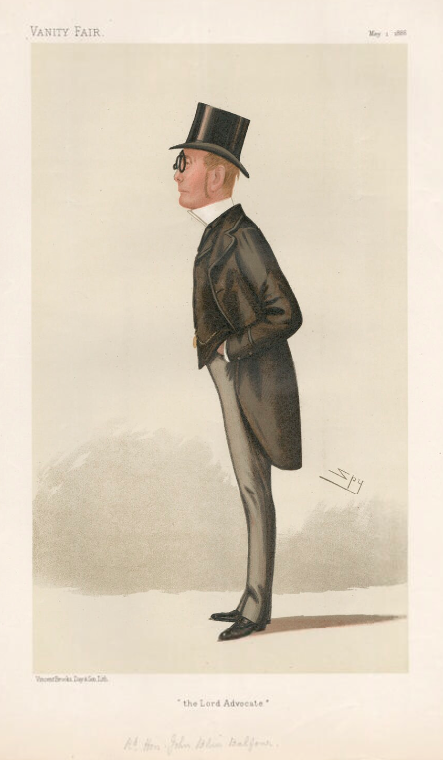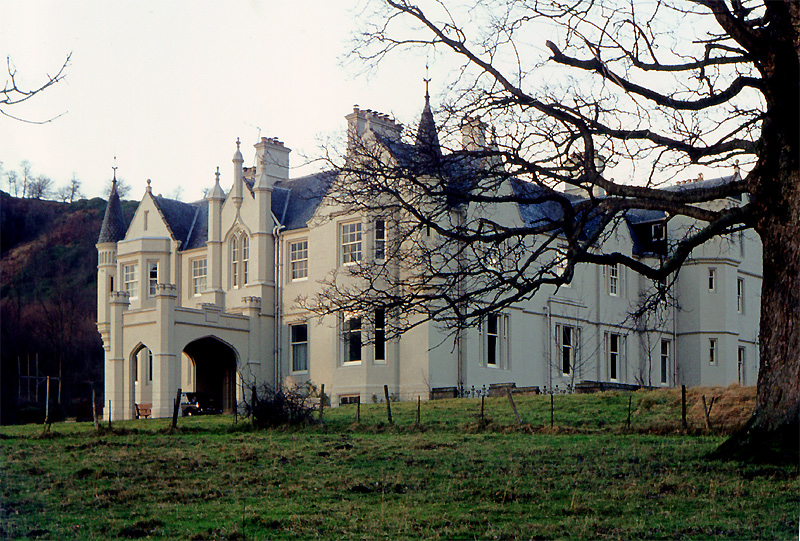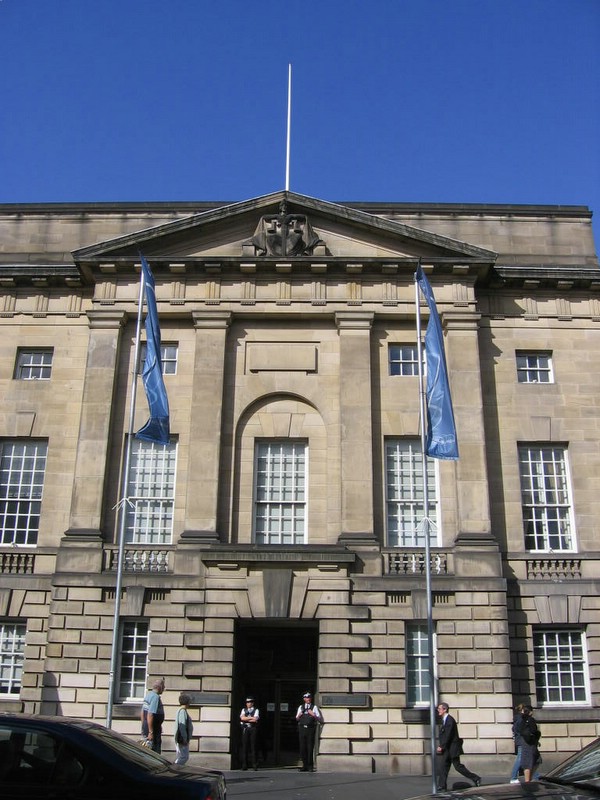|
Donald Mackenzie, Lord Mackenzie
The Hon. Donald Mackenzie, Lord Mackenzie FRSE (22 June 1818 – 19 May 1875) was a Scottish lawyer who served as a Senator of the College of Justice in Edinburgh. Early life Donald Mackenzie was born 22 June 1818, the only son of Margaret Robina Jamieson, daughter of the Rev. John Jamieson, DD, author of the Scottish National Dictionary, and Capt. Donald Mackenzie, of the 21st Fusiliers. In early life the family lived at 39 George Square in south Edinburgh. He studied at the Loretto School and the University of Edinburgh. He originally studied medicine, graduating with an MD at the University of Edinburgh in 1838, and became a licentiate of the Royal College of Physicians and also a Fellow of the Royal College of Surgeons. Mackenzie never practised as a physician, instead, yielding to his mother's wishes, he took up the study of the law. Legal career and later life Mackenzie was admitted as an advocate to the Scottish bar in 1842. He was Advocate Depute from 1854 ... [...More Info...] [...Related Items...] OR: [Wikipedia] [Google] [Baidu] |
FRSE
Fellowship of the Royal Society of Edinburgh (FRSE) is an award granted to individuals that the Royal Society of Edinburgh, Scotland's national academy of science and letters, judged to be "eminently distinguished in their subject". This society received a royal charter in 1783, allowing for its expansion. Elections Around 50 new fellows are elected each year in March. there are around 1,650 Fellows, including 71 Honorary Fellows and 76 Corresponding Fellows. Fellows are entitled to use the post-nominal letters FRSE, Honorary Fellows HonFRSE, and Corresponding Fellows CorrFRSE. Disciplines The Fellowship is split into four broad sectors, covering the full range of physical and life sciences, arts, humanities, social sciences, education, professions, industry, business and public life. A: Life Sciences * A1: Biomedical and Cognitive Sciences * A2: Clinical Sciences * A3: Organismal and Environmental Biology * A4: Cell and Molecular Biology B: Physical, Engineering and ... [...More Info...] [...Related Items...] OR: [Wikipedia] [Google] [Baidu] |
New Town, Edinburgh
The New Town is a central area of Edinburgh, the capital of Scotland. It was built in stages between 1767 and around 1850, and retains much of its original neo-classical and Georgian period architecture. Its best known street is Princes Street, facing Edinburgh Castle and the Old Town across the geological depression of the former Nor Loch. Together with the West End, the New Town was designated a UNESCO World Heritage Site alongside the Old Town in 1995. The area is also famed for the New Town Gardens, a heritage designation since March 2001. Proposal and planning The idea of a New Town was first suggested in the late 17th century when the Duke of Albany and York (later King James VII and II), when resident Royal Commissioner at Holyrood Palace, encouraged the idea of having an extended regality to the north of the city and a North Bridge. He gave the city a grant:That, when they should have occasion to enlarge their city by purchasing ground without the town, or to build ... [...More Info...] [...Related Items...] OR: [Wikipedia] [Google] [Baidu] |
Sheriff Of Lanark
The Sheriff of Lanark or Sheriff of Lanarkshire was historically the royal official responsible for enforcing law and order and bringing criminals to justice in Lanarkshire, Scotland. Prior to 1748 most sheriffdoms were held on a hereditary basis. From that date, following the Jacobite uprising of 1745, the hereditary sheriffs were replaced by salaried sheriff-deputes, qualified advocates who were members of the Scottish Bar. The sheriffdom of Lanarkshire was dissolved in 1975 when it was replaced by the current sheriffdom of South Strathclyde, Dumfries and Galloway. Sheriffs of Lanarkshire *Baldwin of Biggar (1154) *Waldeve of Biggar (1170s) *Hugh, son of Sir Reginald (ca.1196-1200) *William de Hertisheved (1225) *Richard de Coulter (1226) *Alexander Uvieth (Oviot) (1266) *Nicholas de Biggar (1273-1278) *Hugh de Dalzell (1288-1290) *Hugh de Balliol (1290) *Henry St Clair (1293) *Godfrey de Ros (1294) *Andrew Livingstone (1295-1296) *William Heselrig (1296-1297)(assassinated by ... [...More Info...] [...Related Items...] OR: [Wikipedia] [Google] [Baidu] |
Sheriff Of Renfrew And Argyll
The Sheriff of Renfrew and Argyll was historically the royal official responsible for enforcing law and order and bringing criminals to justice in Renfrew and Argyll, Scotland. Prior to 1748 most sheriffdoms were held on a hereditary basis. From that date, following the Jacobite uprising of 1745, the hereditary sheriffs were replaced by salaried sheriff-deputes, qualified advocates who were members of the Scottish Bar. The sheriffdom of Renfrew was combined with the sheriffdom of Bute in 1871, creating the new position of Sheriff of Bute and Renfrew It was merged in 1946 with the sheriffdom of Argyll instead, creating the position of Sheriff of Renfrew and Argyll. That sheriffdom was in turn dissolved in 1975 to be replaced by the current sheriffdom of North Strathclyde. Sheriffs of Renfrew * Sir William Semple, 1471– * Thomas Sempill (killed 1488) * John Sempill, 1st Lord Sempill (1489) (killed 1513) * William Sempill, 2nd Lord Sempill (1515) (died 1552) * Robert S ... [...More Info...] [...Related Items...] OR: [Wikipedia] [Google] [Baidu] |
Sheriff Of Inverness
The Sheriff of Inverness was historically the office responsible for enforcing law and order and bringing criminals to justice in Inverness, Scotland. Prior to 1748 most sheriffdoms were held on a hereditary basis. From that date, following the Jacobite uprising of 1745, the hereditary sheriffs were replaced by salaried sheriff-deputes, qualified advocates who were members of the Scottish Bar. Following mergers the office became the Sheriff of Inverness, Elgin & Nairn in 1882 and the Sheriff of Inverness, Moray, Nairn & Ross & Cromarty in 1946. That sheriffdom was dissolved in turn in 1975 and replaced by that of the Sheriff Principal of Grampian, Highland and Islands. Sheriffs of Inverness * William de Moravia (1204) *William Pratt (1227) *Michael Mowat (1234) *Lawrence Grant (1263) *Alexander Murray (1266) *William de Soulis (1291) *Alan Durward (1291) * Reginald le Chen (1292) *William de la Hay (1295) *John Stirling of Moray (1305-?) * Alexander Pilche (1307-1328) *Maurice ... [...More Info...] [...Related Items...] OR: [Wikipedia] [Google] [Baidu] |
Edinburgh Academy
The Edinburgh Academy is an Independent school (United Kingdom), independent day school in Edinburgh, Scotland, which was opened in 1824. The original building, on Henderson Row in the city's New Town, Edinburgh, New Town, is now part of the Senior School. The Junior School is located on Arboretum Road to the north of the city's Royal Botanic Garden Edinburgh, Royal Botanic Garden. The Edinburgh Academy was originally a day and boarding school for boys. It ceased boarding and transitioned to co-education in 2008 and is now a fully coeducational day school. The nursery, housed in a 2008 purpose built block on the Junior campus, caters for children from age 2 to 5. The Junior School admits children from age 6 to 10 whilst the Senior School takes pupils from age 10 to 18. Foundation In 1822, the school's founders, Henry Thomas Cockburn, Henry Cockburn and Leonard Horner, agreed that Edinburgh required a new school to promote Classics, classical learning. Edinburgh's Royal High Sch ... [...More Info...] [...Related Items...] OR: [Wikipedia] [Google] [Baidu] |
Alexander Low, Lord Low
Alexander Low, Lord Low (1845–1910) was a Scottish lawyer and judge who served as a Senator of the College of Justice. Life He was born on 23 October 1845 the son of Jessy Turnbull of Abbey St. Bathans and her husband, James Low of The Laws, Berwickshire. He was educated at Cheltenham College then studied Moral Science at the University of St Andrews and St John's College, Cambridge. He then began a law course at the University of Edinburgh. He passed the Scottish Bar as an advocate in 1870. In 1875 he was working as an advocate from 1 Queensferry Street in Edinburgh's West End. In 1889 he was made Sheriff of Ross and Cromarty. In November 1890 he was elected a Senator of the College of Justice. In 1895 he was living at 12 Drumsheugh Gardens, a fine Victorian townhouse. He resigned on grounds of ill-health in 1904 and died at the family home of The Laws on 14 October 1910. He was buried at Whitsome churchyard. Cases Lord Low's most noteworthy case was the Free Church o ... [...More Info...] [...Related Items...] OR: [Wikipedia] [Google] [Baidu] |
John Balfour, 1st Baron Kinross
John Blair Balfour, 1st Baron Kinross (11 July 1837 – 22 January 1905) was a Scotland, Scottish lawyer and Liberal Party (UK), Liberal politician who sat in the House of Commons of the United Kingdom, House of Commons from 1880 to 1899. Early life Balfour was born in the manse at Clackmannan, the son of Rev. Peter Balfour ("Perpendicular Peter"), minister of Clackmannan and his wife Jane Ramsay Blair, daughter of John Blair. He was educated at the Edinburgh Academy and then studied law at Edinburgh University, becoming an advocate of the Scottish Bar association, bar in 1861. Career He served as Advocate Depute from 1870 to 1872, and in 1880 was made a Queen's Counsel. He was a Deputy Lieutenant for Edinburgh. At the 1880 United Kingdom general election, 1880 general election, Balfour stood unsuccessfully for parliament at Ayrshire North (UK Parliament constituency), Ayrshire North but in a by election six months later was elected Liberal Party (UK), Liberal Member of Par ... [...More Info...] [...Related Items...] OR: [Wikipedia] [Google] [Baidu] |
Sir Archibald Campbell, 1st Baronet
General Sir Archibald Campbell, 1st Baronet (12 March 1769 – 6 October 1843) was a Scottish soldier who served as an officer in the British Army. From 1824 to 1826, Gen. Campbell commanded the British forces in the First Anglo-Burmese War, the longest and most expensive war in British Indian history, that gave the British control of Assam, Manipur, Cachar, Jaintia, Arakan and Tenasserim. He became known as the "Hero of Ava". From 1831 to 1837, he was the administrator of the colony of New Brunswick, Canada. The Canadian city of Campbellton in the province of New Brunswick was named in his honour. Early life Archibald was born 12 March 1769, at Glen Lyon, Perthshire, and educated at Tonbridge School, Kent, England. He was the third son of Captain Archibald Campbell and his wife Margaret Small of Dirnanean, daughter of Captain James Small, factor of the forfeited estates of the Robertsons of Struan. Archibald was a descendant of the Robertsons through his maternal gre ... [...More Info...] [...Related Items...] OR: [Wikipedia] [Google] [Baidu] |
Ayrshire
Ayrshire ( gd, Siorrachd Inbhir Àir, ) is a historic county and registration county in south-west Scotland, located on the shores of the Firth of Clyde. Its principal towns include Ayr, Kilmarnock and Irvine and it borders the counties of Renfrewshire and Lanarkshire to the north-east, Dumfriesshire to the south-east, and Kirkcudbrightshire and Wigtownshire to the south. Like many other counties of Scotland it currently has no administrative function, instead being sub-divided into the council areas of North Ayrshire, South Ayrshire and East Ayrshire. It has a population of approximately 366,800. The electoral and valuation area named Ayrshire covers the three council areas of South Ayrshire, East Ayrshire and North Ayrshire, therefore including the Isle of Arran, Great Cumbrae and Little Cumbrae. These three islands are part of the historic County of Bute and are sometimes included when the term ''Ayrshire'' is applied to the region. The same area is known as ''Ayrshire a ... [...More Info...] [...Related Items...] OR: [Wikipedia] [Google] [Baidu] |
Dean Cemetery
The Dean Cemetery is a historically important Victorian cemetery north of the Dean Village, west of Edinburgh city centre, in Scotland. It lies between Queensferry Road and the Water of Leith, bounded on its east side by Dean Path and on its west by the Dean Gallery. A 20th-century extension lies detached from the main cemetery to the north of Ravelston Terrace. The main cemetery is accessible through the main gate on its east side, through a "grace and favour" access door from the grounds of Dean Gallery and from Ravelston Terrace. The modern extension is only accessible at the junction of Dean Path and Queensferry Road. The cemetery Dean Cemetery, originally known as Edinburgh Western Cemetery, was laid out by David Cousin (an Edinburgh architect who also laid out Warriston Cemetery) in 1846 and was a fashionable burial ground for mainly the middle and upper-classes. The many monuments bear witness to Scottish achievement in peace and war, at home and abroad and are a ... [...More Info...] [...Related Items...] OR: [Wikipedia] [Google] [Baidu] |
College Of Justice
The College of Justice includes the Supreme Courts of Scotland, and its associated bodies. The constituent bodies of the national supreme courts are the Court of Session, the High Court of Justiciary, the Office of the Accountant of Court, and the Auditor of the Court of Session. Its associated bodies are the Faculty of Advocates, the Society of Writers to Her Majesty's Signet and the Society of Solicitors in the Supreme Courts of Scotland. The College is headed by the Lord President of the Court of Session, who also holds the title of Lord Justice General in relation to the High Court of Justiciary, and judges of the Court of Session and High Court are titled Senators of the College of Justice. History The College was founded in 1532 by King James V following a bull issued by Pope Clement VII on 15 September 1531. It provided for 10,000 gold ducats to be contributed by the Scottish bishoprics and monastic institutions for the maintenance of its members, one half of ... [...More Info...] [...Related Items...] OR: [Wikipedia] [Google] [Baidu] |





